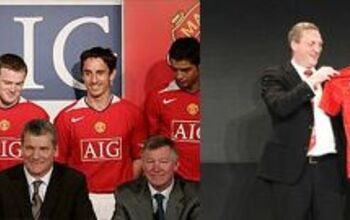Does GM Have Negative Equity?
Digging through the finances of a company as large as GM is never an easy task, especially when the balance book in question was recently wiped clean in a bailout-bankruptcy. Luckily, Bloomberg columnist Jonathan Weil has the chops to do the task justice, and he’s come up with a fascinating insight: through the power of an accounting tool known as “Goodwill,” Weil claims that GM has juiced its assets and liabilities during its “fresh start.” He notes with TTACian zeal:
It’s as if a $30.2 billion asset suddenly materialized out of thin air. In the upside-down world that is GM’s balance sheet, that’s exactly what happened.
The short version: GM undervalued some assets and overvalued some liabilities during its “fresh start.” The scary result: improvement in GM’s performance and creditworthiness could actually lead to writedowns on its Goodwill… which is currently The General’s largest non-current asset. Oh yes, and without that $30.2b in Goodwill, GM would have about an equity value of -$6.3b. Welcome to the new General Motors…
GM’s pre-IPO S1 filing has this to say about Goodwill:
At December 31, 2009 Goodwill was $30.7 billion. In connection with our application of fresh-start reporting, we recorded Goodwill of $30.5 billion at July 10, 2009. When applying fresh-start reporting, certain accounts, primarily employee benefit and income tax related, were recorded at amounts determined under specific U.S. GAAP rather than fair value and the difference between the U.S. GAAP and fair value amounts gave rise to goodwill, which is a residual. Our employee benefit related accounts were recorded in accordance with ASC 712, “Compensation—Nonretirement Postemployment Benefits” and ASC 715, “Compensation—Retirement Benefits” and deferred income taxes were recorded in accordance with ASC 740, “Income Taxes”.
Further, we recorded valuation allowances against certain of our deferred tax assets, which under ASC 852 also resulted in goodwill.
But, Weil points out that
This isn’t the way goodwill normally works. Usually it comes about when one company buys another company. The acquirer records the other company’s net assets on its books at their fair market value. It then records the difference between the purchase price and the net assets it bought as goodwill…
GM’s explanation? The company said it wouldn’t have registered any goodwill under fresh-start reporting if it had booked all its identifiable assets and liabilities at their fair market values. However, GM recorded some of its liabilities at amounts that exceeded fair value, primarily related to employee benefits. The company said the decision was in accordance with U.S. accounting standards on the subject.
Confused? You probably should be. Unfortunately, Weil doesn’t get any more specific about what assets GM over- and under-valued, but he does explain the mechanics of just how this short-term tactic could hurt GM over the longer term.
The difference between those liabilities’ carrying amounts and fair values gave rise to goodwill. The bigger the difference, the more goodwill GM booked. In other instances, GM said it recorded certain tax assets at less than their fair value, which also resulted in goodwill.
On the liabilities side, for example, GM said the fair values were lower than the carrying amounts on its balance sheet because it used higher discount rates to calculate the fair value figures. The higher discount rates took GM’s own risk of default into account, which drove the fair values lower.
Here’s where it gets really funky. If GM’s creditworthiness improves, this would reduce the difference between the liabilities’ fair values and carrying amounts. Put another way, GM said, the goodwill balance implied by that spread would decline. That could make GM’s goodwill vulnerable to writedowns in future periods, which would reduce earnings.
A similar effect would ensue on the asset side if GM’s long-term profit forecasts improved. Under that scenario, GM could recognize higher tax assets and bring their carrying amount closer to fair value, narrowing the spread between them.
So, to sum up, the stronger and more creditworthy GM becomes, the less its goodwill assets may be worth in the future. An intuitive outcome, this is not.
No doubt, but neither is it the most shocking news ever. After all, GM has a long and rich history of sacrificing long-term health in order to book short-term gains. And if GM admits, as Weil claims, that absent a deliberate overvaluation of assets it would have negative equity going into its IPO, that’s clearly one bad habit that is dying hard. Add the fact that GM also admits to having problems with its financial controls and an inexperienced CEO, and it becomes difficult to understand why anyone should consider investing in the government-owned automaker. If, at fair market valuations, GM is worth negative equity after taxpayers dropped $50b on it, one can’t help but wonder what the bailout bought.
More by Edward Niedermeyer
Latest Car Reviews
Read moreLatest Product Reviews
Read moreRecent Comments
- TheEndlessEnigma Of course they should unionize. US based automotive production component production and auto assembly plants with unionized memberships produce the highest quality products in the automotive sector. Just look at the high quality products produced by GM, Ford and Chrysler!
- Redapple2 Got cha. No big.
- Theflyersfan The wheel and tire combo is tragic and the "M Stripe" has to go, but overall, this one is a keeper. Provided the mileage isn't 300,000 and the service records don't read like a horror novel, this could be one of the last (almost) unmodified E34s out there that isn't rotting in a barn. I can see this ad being taken down quickly due to someone taking the chance. Recently had some good finds here. Which means Monday, we'll see a 1999 Honda Civic with falling off body mods from Pep Boys, a rusted fart can, Honda Rot with bad paint, 400,000 miles, and a biohazard interior, all for the unrealistic price of $10,000.
- Theflyersfan Expect a press report about an expansion of VW's Mexican plant any day now. I'm all for worker's rights to get the best (and fair) wages and benefits possible, but didn't VW, and for that matter many of the Asian and European carmaker plants in the south, already have as good of, if not better wages already? This can drive a wedge in those plants and this might be a case of be careful what you wish for.
- Jkross22 When I think about products that I buy that are of the highest quality or are of great value, I have no idea if they are made as a whole or in parts by unionized employees. As a customer, that's really all I care about. When I think about services I receive from unionized and non-unionized employees, it varies from C- to F levels of service. Will unionizing make the cars better or worse?


































Comments
Join the conversation
Question: is GM taking in more money than it spends?
Ed, you do get that this is a goofy artifact of the accounting rules, not some secret GM fraud, right? Pinning this on old GM culture is kind of disingenuous when CFO Chris Liddell is pretty much the antithesis of a short-sighted GM lifer, and has been nothing but blunt and direct in his dealings with analysts and the media. You can love the company or hate it -- the sensible position is probably some of both -- but at least at the C-level, it ain't the same old GM.